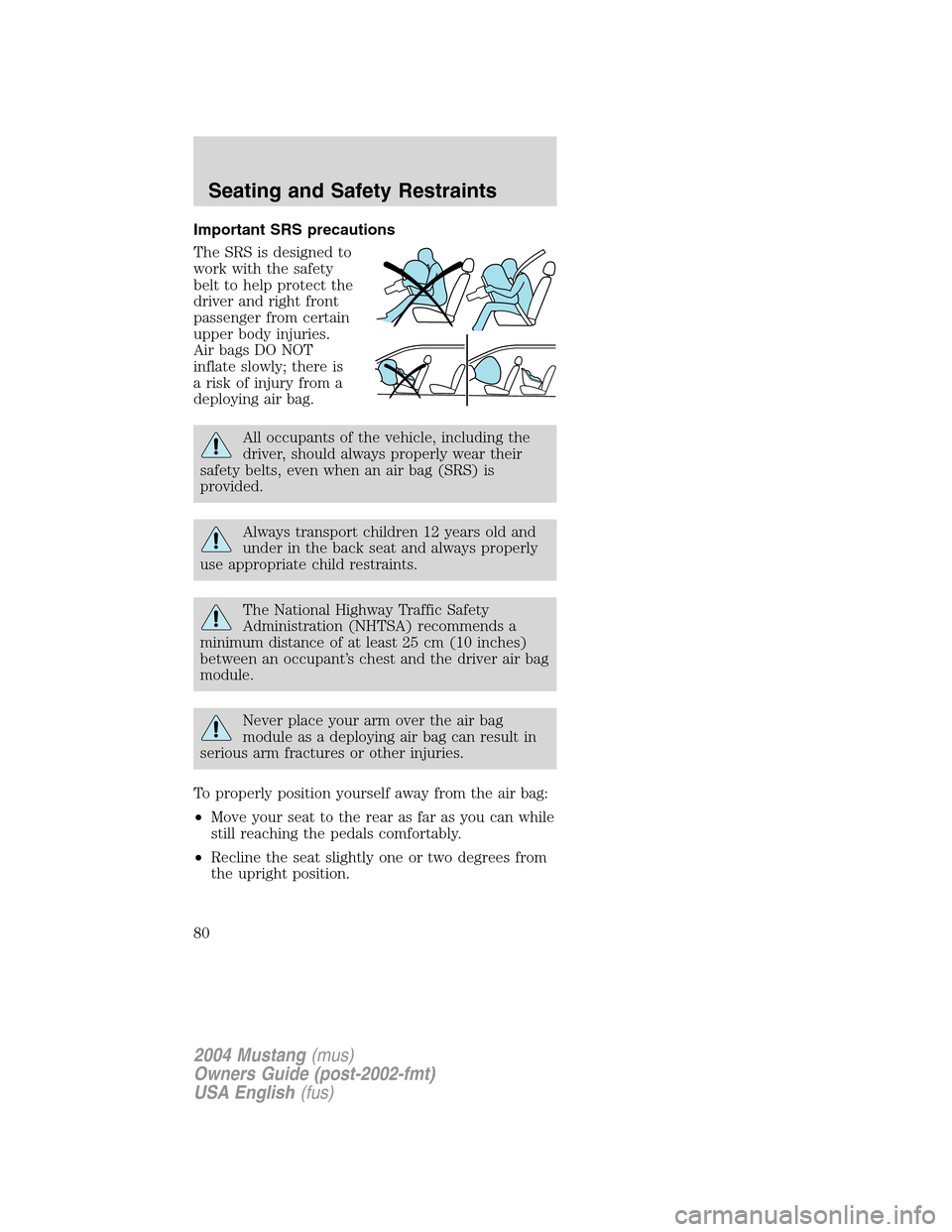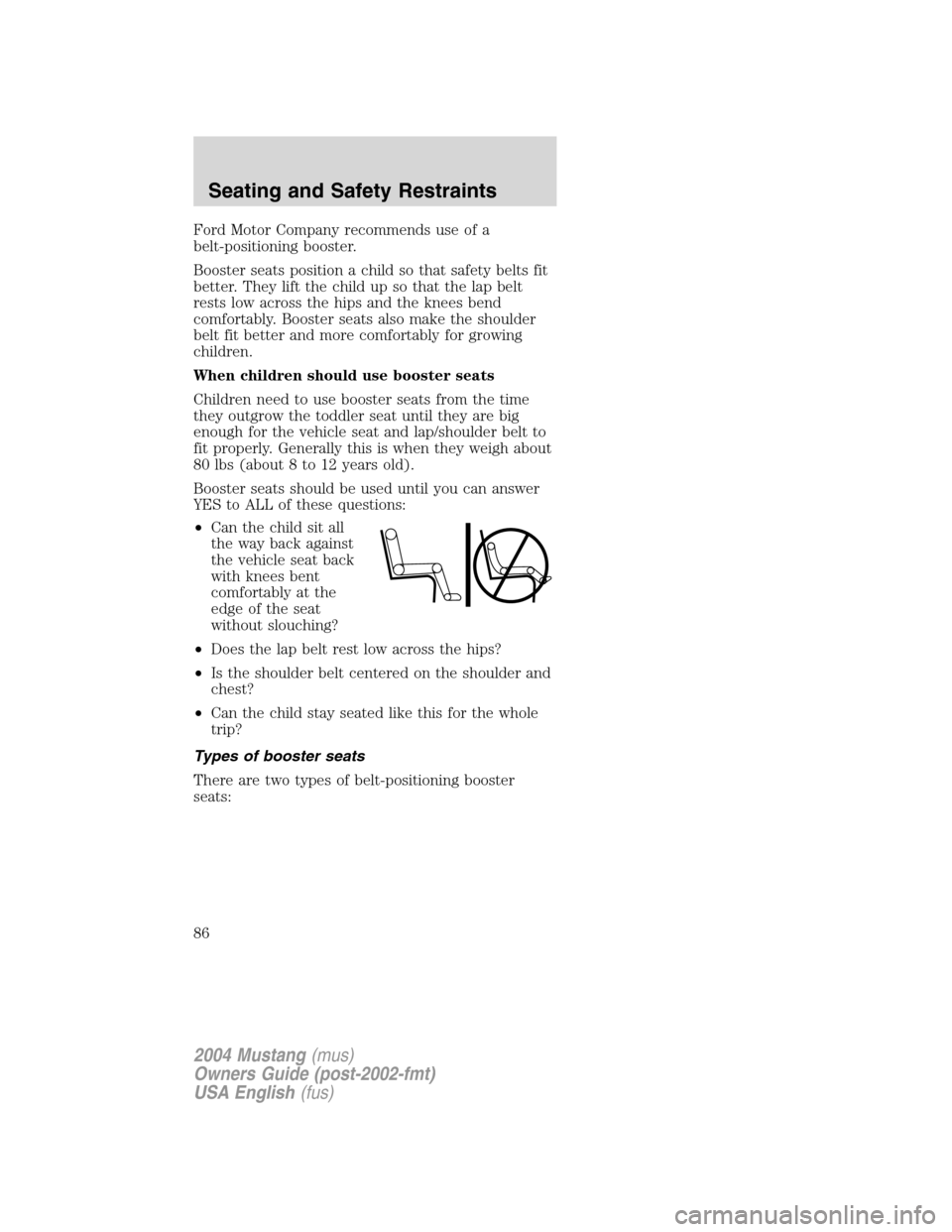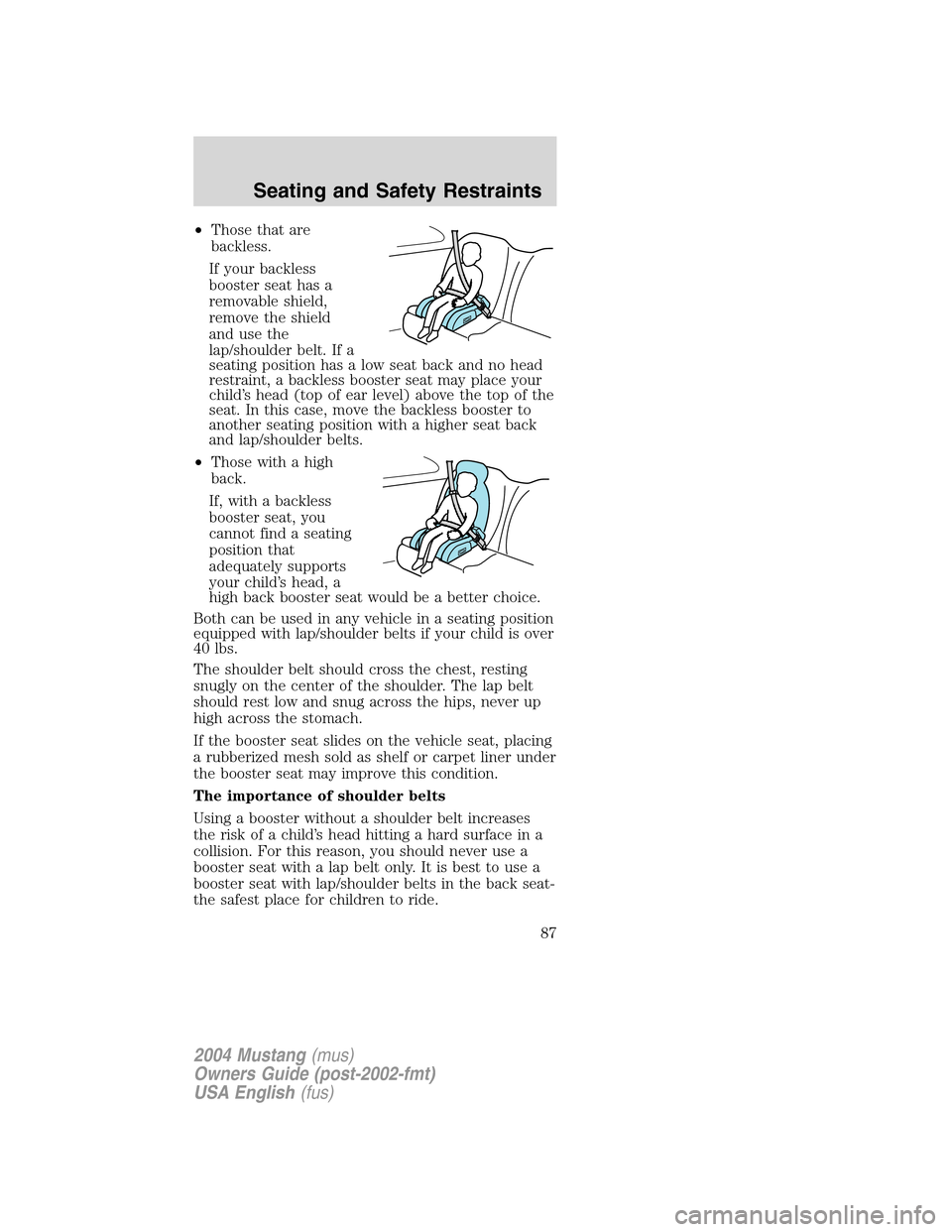Page 77 of 240

•The gearshift is in P (Park) (automatic
transmission) or the neutral position (manual
transmission).
•The ignition switch is in the OFF position.
•All vehicle doors are closed.
•The driver’s safety belt is unbuckled.
•The parklamps/headlamps are in OFF position (If
vehicle is equipped with Autolamps, this will not
affect the procedure).
To reduce the risk of injury, do not
deactivate/activate the Belt Minder feature
while driving the vehicle.
BeltMinder activation and deactivation
procedure
1. Turn the ignition switch to the RUN (or ON)
position. (DO NOT START THE ENGINE.)
2. Wait until the safety belt warning light turns off.
(Approximately 1–2 minutes.)
•Steps 3–5 must be completed within 60 seconds
or the procedure will have to be repeated.
3. Buckle then unbuckle the safety belt three times,
ending with the safety belt unbuckled. This can be
done before or during BeltMinder warning activation.
4. Turn on the parklamps/headlamps, turn off the
parklamps/headlamps.
5. Buckle then unbuckle the safety belt three times,
ending with the safety belt unbuckled.
•After step 5 the safety belt warning light will be
turned on for three seconds.
6. Within seven seconds of the safety belt warning
light turning off, buckle then unbuckle the safety
belt.
•This will disable BeltMinder if it is currently
enabled, or enable BeltMinder if it is currently
disabled.
2004 Mustang(mus)
Owners Guide (post-2002-fmt)
USA English(fus)
Seating and Safety Restraints
77
Page 78 of 240

7. Confirmation of disabling BeltMinder is provided
by the safety belt warning light flashing four times
per second for three seconds.
8. Confirmation of enabling BeltMinder is provided
by:
•The safety belt warning light flashing four times
per second for three seconds.
•Followed by three seconds with the safety belt
warning light off.
•Once again, the safety belt warning light will flash
four times per second for three seconds.
9. After receiving confirmation, the
deactivation/activation procedure is complete.
Safety belt extension assembly
If the safety belt is too short when fully extended,
there is a 20 cm (8 inch) safety belt extension
assembly that can be added (part number 611C22).
This assembly can be obtained from your dealer at
no cost.
Use only extensions manufactured by the same
supplier as the safety belt. Manufacturer
identification is located at the end of the webbing on
the label. Also, use the safety belt extension only if
the safety belt is too short for you when fully
extended.
Do not use extensions to change the fit of
the shoulder belt across the torso.
Safety belt maintenance
Inspect the safety belt systems periodically to make
sure they work properly and are not damaged.
Inspect the safety belts to make sure there are no
nicks, tears or cuts. Replace if necessary. All safety
belt assemblies, including retractors, buckles, front
seat belt buckle assemblies, buckle support
assemblies (slide bar-if equipped), shoulder belt
height adjusters (if equipped), shoulder belt guide
2004 Mustang(mus)
Owners Guide (post-2002-fmt)
USA English(fus)
Seating and Safety Restraints
78
Page 79 of 240
on seatback (if equipped), child safety seat LATCH
and tether anchors, and attaching hardware, should
be inspected after a collision. Ford Motor Company
recommends that all safety belt assemblies in use in
vehicles involved in a collision be replaced. However,
if the collision was minor and a qualified technician
finds that the belts do not show damage and
continue to operate properly, they do not need to be
replaced. Safety belt assemblies not in use during a
collision should also be inspected and replaced if
either damage or improper operation is noted.
Failure to inspect and if necessary replace
the safety belt assembly under the above
conditions could result in severe personal injuries
in the event of a collision.
Refer toInteriorin theCleaningchapter.
AIR BAG SUPPLEMENTAL RESTRAINT SYSTEM
(SRS)
2004 Mustang(mus)
Owners Guide (post-2002-fmt)
USA English(fus)
Seating and Safety Restraints
79
Page 80 of 240

Important SRS precautions
The SRS is designed to
work with the safety
belt to help protect the
driver and right front
passenger from certain
upper body injuries.
Air bags DO NOT
inflate slowly; there is
a risk of injury from a
deploying air bag.
All occupants of the vehicle, including the
driver, should always properly wear their
safety belts, even when an air bag (SRS) is
provided.
Always transport children 12 years old and
under in the back seat and always properly
use appropriate child restraints.
The National Highway Traffic Safety
Administration (NHTSA) recommends a
minimum distance of at least 25 cm (10 inches)
between an occupant’s chest and the driver air bag
module.
Never place your arm over the air bag
module as a deploying air bag can result in
serious arm fractures or other injuries.
To properly position yourself away from the air bag:
•Move your seat to the rear as far as you can while
still reaching the pedals comfortably.
•Recline the seat slightly one or two degrees from
the upright position.
2004 Mustang(mus)
Owners Guide (post-2002-fmt)
USA English(fus)
Seating and Safety Restraints
80
Page 85 of 240

of your vehicle. Accident statistics suggest that
children are safer when properly restrained in the
rear seating positions than in the front seating
position.
Never let a passenger hold a child on his or
her lap while the vehicle is moving. The
passenger cannot protect the child from injury in a
collision.
Always follow the instructions and warnings that
come with any infant or child restraint you might
use.
Children and safety belts
If the child is the proper size, restrain the child in a
safety seat. Children who are too large for child
safety seats (as specified by your child safety seat
manufacturer) should always wear safety belts.
Follow all the important safety restraint and air bag
precautions that apply to adult passengers in your
vehicle.
If the shoulder belt portion of a combination lap and
shoulder belt can be positioned so it does not cross
or rest in front of the child’s face or neck, the child
should wear the lap and shoulder belt. Moving the
child closer to the center of the vehicle may help
provide a good shoulder belt fit.
Do not leave children, unreliable adults, or
pets unattended in your vehicle.
Child booster seats
Children outgrow a typical convertible or toddler
seat when they weigh 40 pounds and are around 4
years of age. Although the lap/shoulder belt will
provide some protection, these children are still too
small for lap/shoulder belts to fit properly, which
could increase the risk of serious injury.
To improve the fit of both the lap and shoulder belt
on children who have outgrown child safety seats,
2004 Mustang(mus)
Owners Guide (post-2002-fmt)
USA English(fus)
Seating and Safety Restraints
85
Page 86 of 240

Ford Motor Company recommends use of a
belt-positioning booster.
Booster seats position a child so that safety belts fit
better. They lift the child up so that the lap belt
rests low across the hips and the knees bend
comfortably. Booster seats also make the shoulder
belt fit better and more comfortably for growing
children.
When children should use booster seats
Children need to use booster seats from the time
they outgrow the toddler seat until they are big
enough for the vehicle seat and lap/shoulder belt to
fit properly. Generally this is when they weigh about
80 lbs (about 8 to 12 years old).
Booster seats should be used until you can answer
YES to ALL of these questions:
•Can the child sit all
the way back against
the vehicle seat back
with knees bent
comfortably at the
edge of the seat
without slouching?
•Does the lap belt rest low across the hips?
•Is the shoulder belt centered on the shoulder and
chest?
•Can the child stay seated like this for the whole
trip?
Types of booster seats
There are two types of belt-positioning booster
seats:
2004 Mustang(mus)
Owners Guide (post-2002-fmt)
USA English(fus)
Seating and Safety Restraints
86
Page 87 of 240

•Those that are
backless.
If your backless
booster seat has a
removable shield,
remove the shield
and use the
lap/shoulder belt. If a
seating position has a low seat back and no head
restraint, a backless booster seat may place your
child’s head (top of ear level) above the top of the
seat. In this case, move the backless booster to
another seating position with a higher seat back
and lap/shoulder belts.
•Those with a high
back.
If, with a backless
booster seat, you
cannot find a seating
position that
adequately supports
your child’s head, a
high back booster seat would be a better choice.
Both can be used in any vehicle in a seating position
equipped with lap/shoulder belts if your child is over
40 lbs.
The shoulder belt should cross the chest, resting
snugly on the center of the shoulder. The lap belt
should rest low and snug across the hips, never up
high across the stomach.
If the booster seat slides on the vehicle seat, placing
a rubberized mesh sold as shelf or carpet liner under
the booster seat may improve this condition.
The importance of shoulder belts
Using a booster without a shoulder belt increases
the risk of a child’s head hitting a hard surface in a
collision. For this reason, you should never use a
booster seat with a lap belt only. It is best to use a
booster seat with lap/shoulder belts in the back seat-
the safest place for children to ride.
2004 Mustang(mus)
Owners Guide (post-2002-fmt)
USA English(fus)
Seating and Safety Restraints
87
Page 88 of 240
Follow all instructions provided by the
manufacturer of the booster seat.
Never put the shoulder belt under a child’s
arm or behind the back because it
eliminates the protection for the upper part of the
body and may increase the risk of injury or death
in a collision.
Never use pillows, books, or towels to boost
a child. They can slide around and increase
the likelihood of injury or death in a collision.
SAFETY SEATS FOR CHILDREN
Child and infant or child safety seats
Use a safety seat that is recommended for the size
and weight of the child. Carefully follow all of the
manufacturer’s instructions with the safety seat you
put in your vehicle. If you do not install and use the
safety seat properly, the child may be injured in a
sudden stop or collision.
When installing a child safety seat:
2004 Mustang(mus)
Owners Guide (post-2002-fmt)
USA English(fus)
Seating and Safety Restraints
88